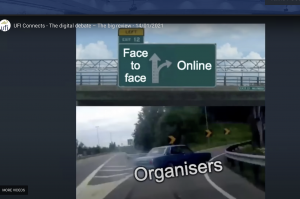 The trade show industry has been protected from having to go digital because the power of face-to-face for exhibitions has historically been so strong. With the pandemic temporarily curtailing in-person gatherings, trade show organizers have been forced to bring their events online. Was this the healthy shock the industry needed to get serious about online shows, or was it just a digital detour on our way back to full recovery for in-person shows?
The trade show industry has been protected from having to go digital because the power of face-to-face for exhibitions has historically been so strong. With the pandemic temporarily curtailing in-person gatherings, trade show organizers have been forced to bring their events online. Was this the healthy shock the industry needed to get serious about online shows, or was it just a digital detour on our way back to full recovery for in-person shows?
That’s one of the questions an expert panel debated during a UFI Connects session held January 21 by UFI, the global association for the exhibition industry.
As panelist Stephan Forseilles, Head of Technology and Digital Transformation, Easyfairs, pointed out, some people, such as Bill Gates, are predicting that more than half of business travel — including those traveling to attend trade shows — will disappear in the post-coronavirus world. Online exhibitions may, in fact, be here to stay.
So where do we stand now in the digital journey, and how far do we still need to go? Here’s some of what the panelists, who also included Matthias Tesi Baur, CEO, MBB Consulting Group; and Gunnar Heinrich, CEO & Managing Partner, adventics GmbH, had to say.
Trade Shows: Digital, or Just Pseudodigital?
 “When we first asked [if the industry is only doing pseudodigital in a pre-coronavirus UFI Connects session], the answer was easy,” said Baur. “Ninety percent said we don’t do real digitization.”
“When we first asked [if the industry is only doing pseudodigital in a pre-coronavirus UFI Connects session], the answer was easy,” said Baur. “Ninety percent said we don’t do real digitization.”
But an audience poll at the January session showed that this hasn’t changed much, with about 80% saying the industry is still just pseudo-digitizing instead of committing to a real strategy.
“Many companies thought once you choose the right platform, the problem is solved,” at least until we can get back to face-to-face exhibitions, because digital can never deliver what face to face can, said Baur.
“I think this is a mistake,” he added. “We should enhance our model with digital” and not wait to get back to the old normal, because there won’t be a new normal.
Related. UFI Launches Online Series Program: UFI Connects
Heinrich agreed that while the pandemic has accelerated the digitization, there’s still a long way to go. Some of the challenges that remain to be surmounted include:
- An inability to integrate digital into all the other pieces of a trade show’s data stream, from registration to content management. “We may have a good user interface (UI), but it needs to be integrated into your existing systems,” said Heinrich.
- Revenues that still don’t cover the costs of going digital. “Some say you’re not truly digital if you’re not making comparable amounts of revenue in digital as in physical,” said Forseilles.
- Providing a digital experience comparable to what people have come to expect from consumer digital giants such as Amazon. Part of the problem, said Forseilles, may be that we’re just taking a cookie cutter approach and trying to transfer existing events to online versions, rather than developing a strategy specifically for online shows. “We had an excuse [in 2020] because everything moved so fast. Now we can take the time to come back better, connect with the customer, and even make money on digital trade shows. The question is do we continue, or do we go back to the old ways with live exhibitions? There’s a danger to that.”
Related. Freeman Doubles Down on Data-Driven Event Recovery Research
- Getting up to speed on progressive profiling technology. “It’s not enough anymore to survey visitors while they are buying a ticket. We can learn a lot from digital platforms like Facebook and Amazon,” said Heinrich. While many show organizers don’t know what to do with the wealth of data the platforms provide, “they could combine all that data from the registration system, polling, etc., to build a proper profile” that could be used to generate revenue.
- Online events are still seen as a risk to in-person trade shows. Forseilles emphasized that this is not the case, using the example of the TED Conference, which has only grown demand for its very expensive in-person events since it began offering its TED Talks digitally.
- Trying to do it all yourself. “Why invest in broadcast studios and camera technology? Organizers should look for clever alliances and leave the feel to companies that have more experience in this area, not do everything themselves,” said Heinrich.
- Private companies are doing a better job of providing digital trade shows than traditional trade show organizers. Panelists cited companies such as Salesforce and Apple as being ahead of the online show game because they are quicker to jump on new technologies and form joint ventures to pay for them because, as Heinrich said, “It’s all about survival for them.”
“It’s not only worrying, it’s heartbreaking,” said Baur, “because who has access to the right people? Who has the name in the industry? It’s us. When we are on the starting line of this marathon run, we are in the pole position, and yet the new kids on the block outperform us.”
For more of the discussion, including the potential impact of artificial intelligence on trade shows, visit UFI Connects.











